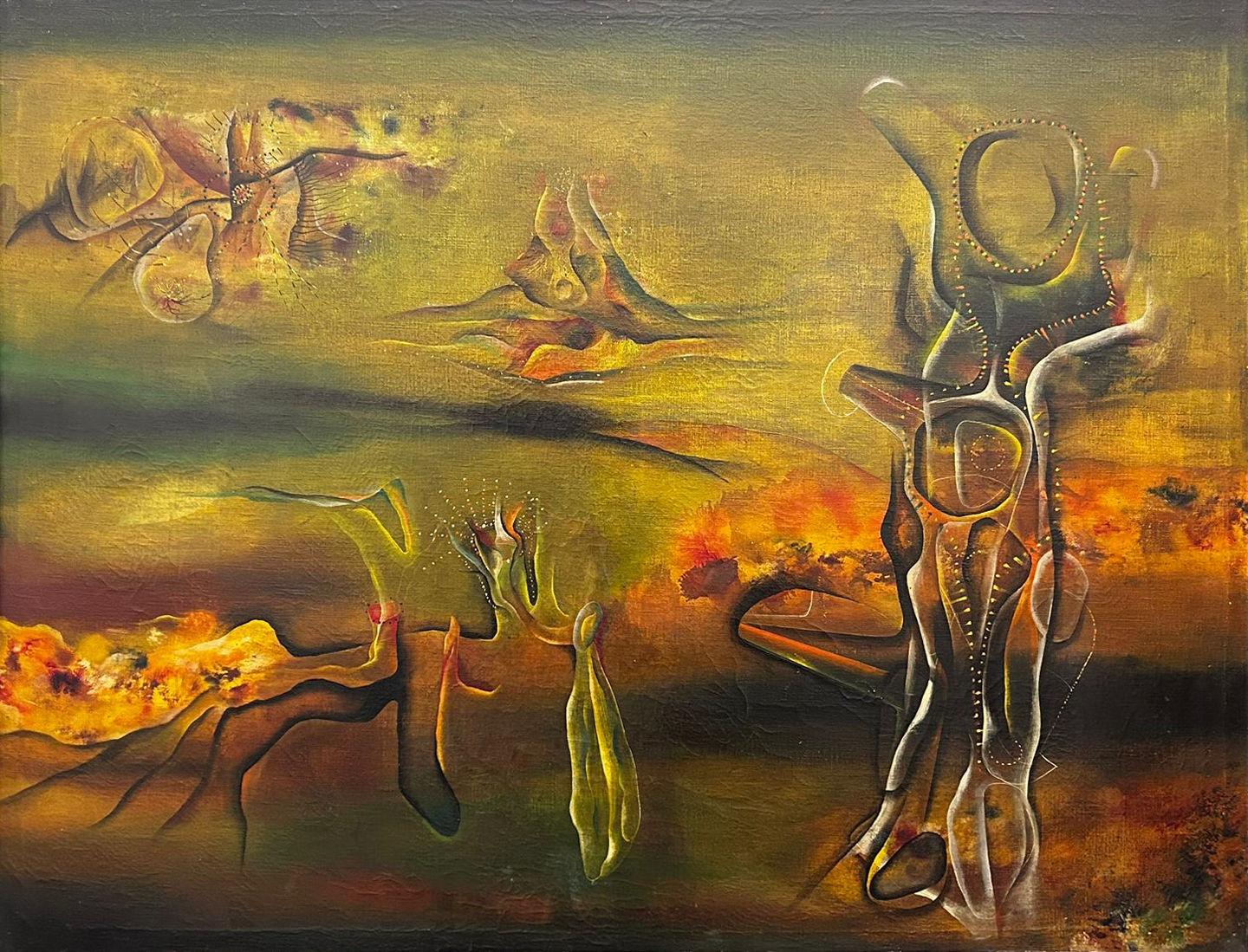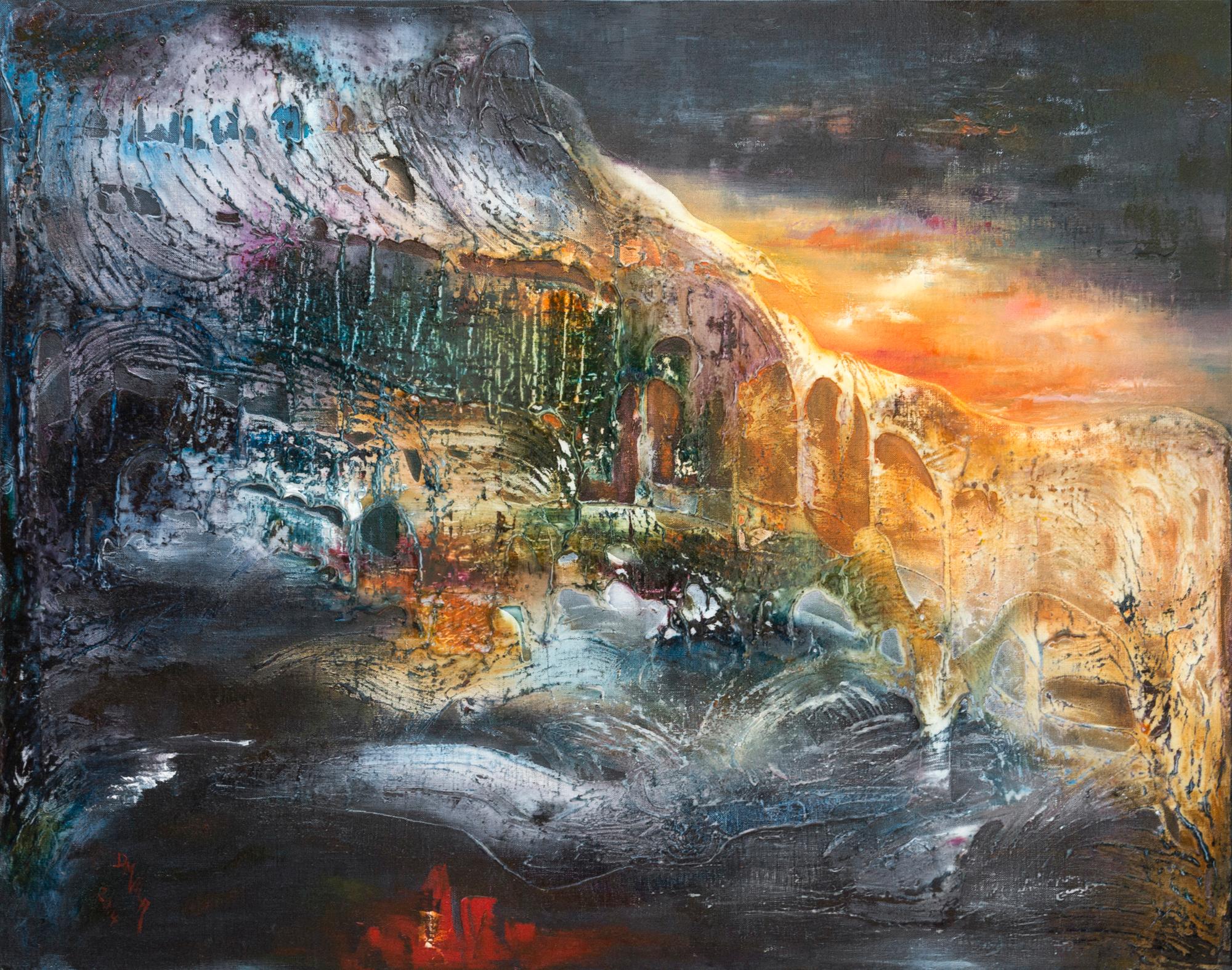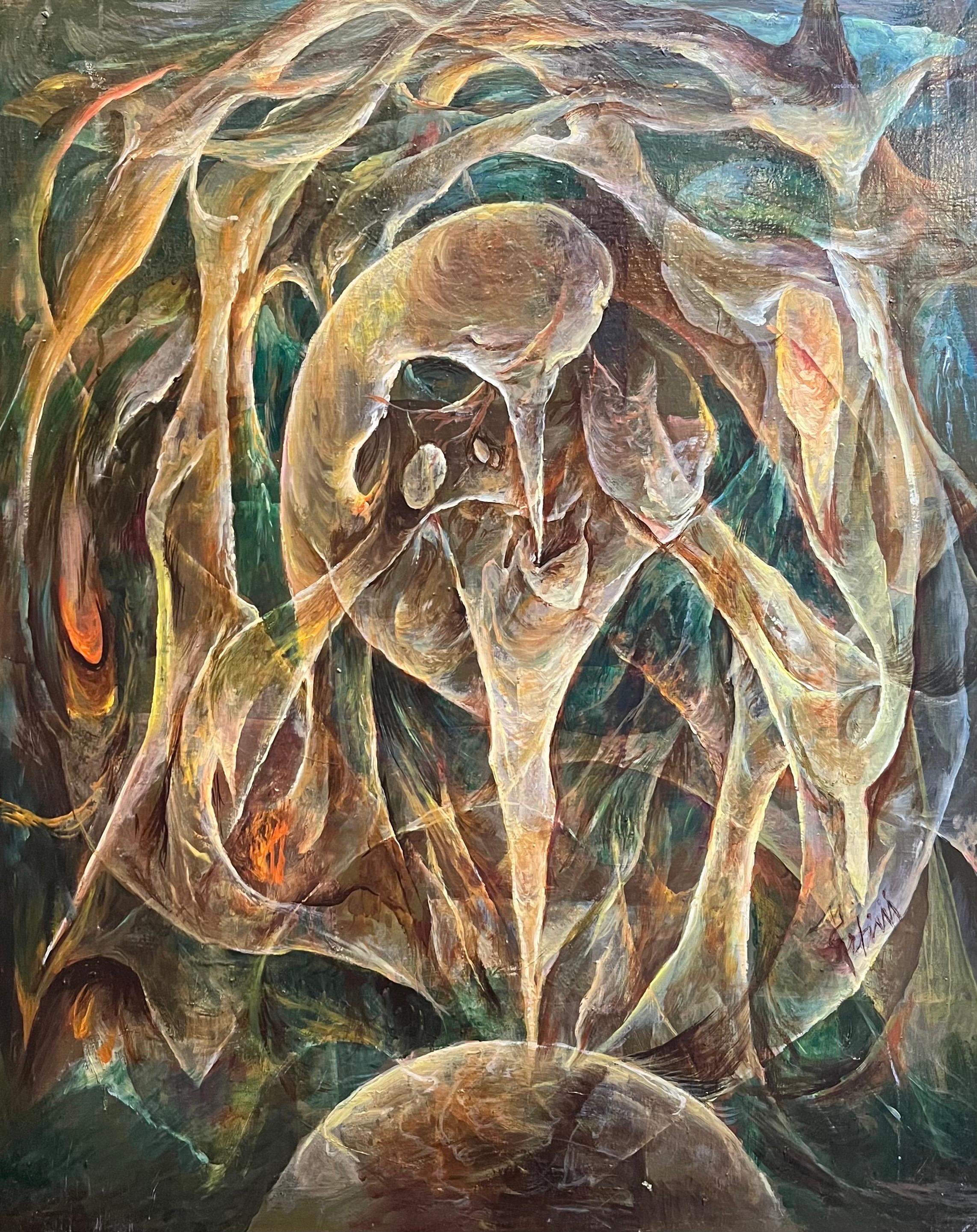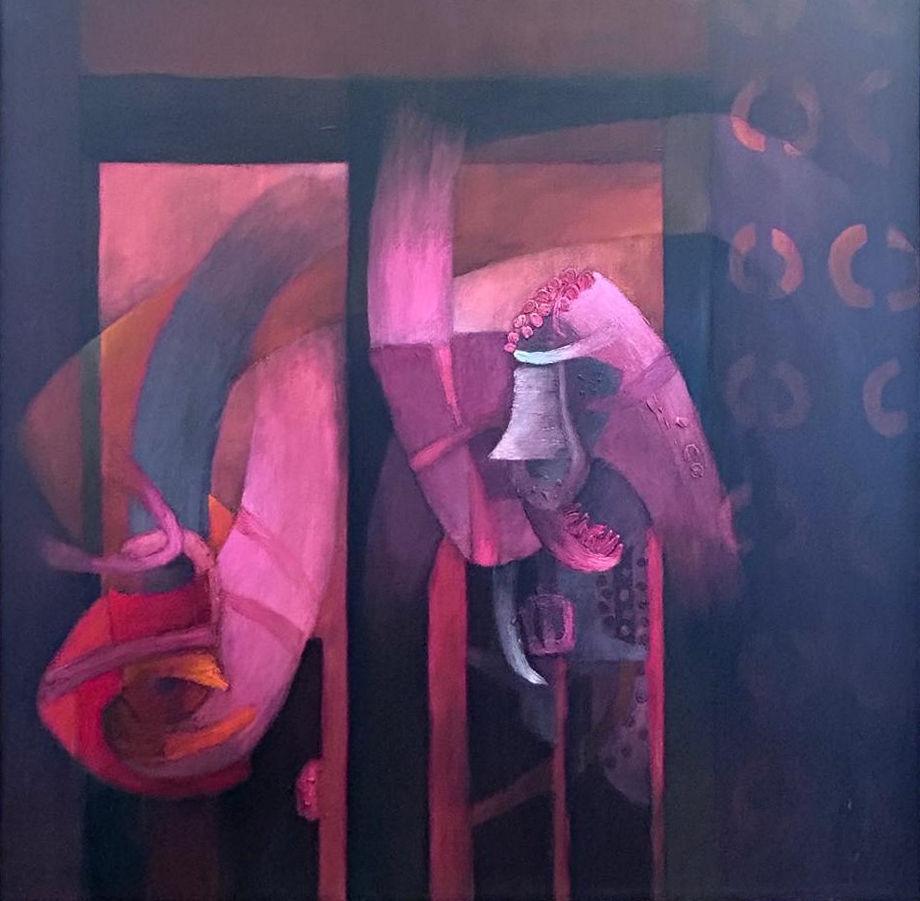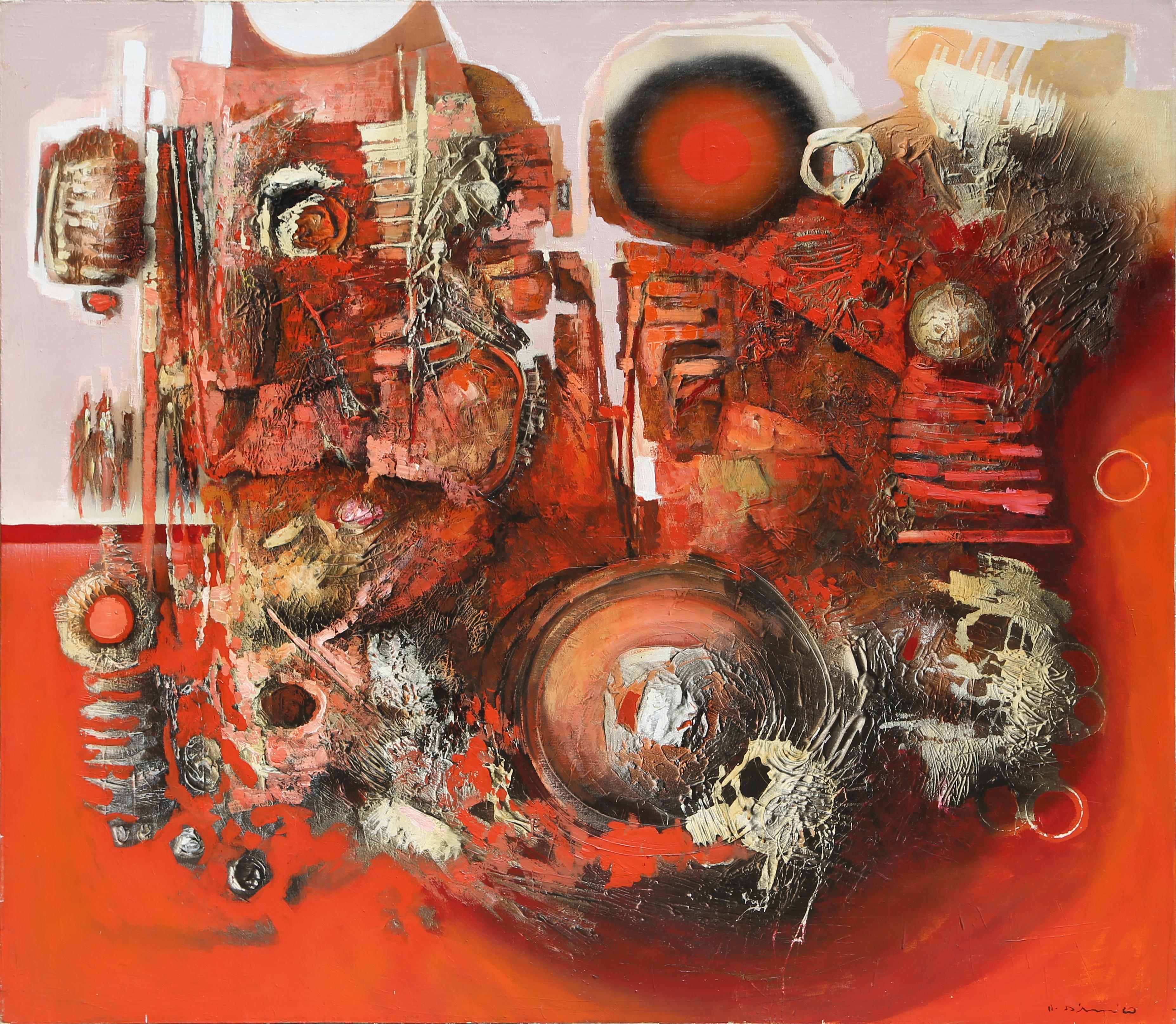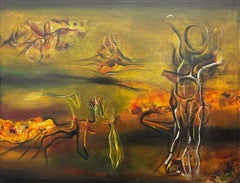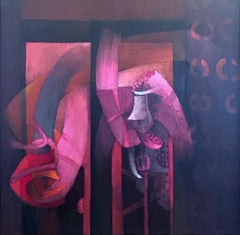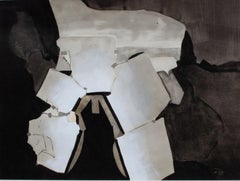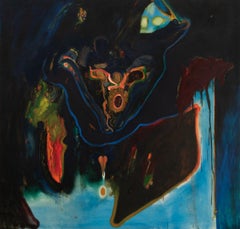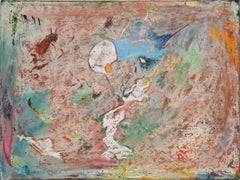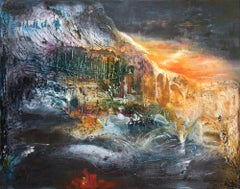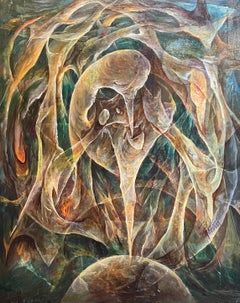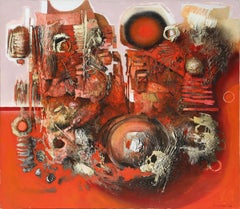Items Similar to "Cave Drama" Boris Margo, Abstract Surrealism, Surrealist landscape, Modernist
Want more images or videos?
Request additional images or videos from the seller
1 of 10
Boris Margo"Cave Drama" Boris Margo, Abstract Surrealism, Surrealist landscape, Modernist1938
1938
$24,000
£18,123.84
€20,750.13
CA$33,894.27
A$37,004.43
CHF 19,399.91
MX$449,433.09
NOK 242,273.30
SEK 228,770.59
DKK 154,877.62
About the Item
Boris Margo
Cave Drama, 1938
Signed and dated lower left
Oil on canvas
22 x 30 inches
Best known as a painter of surrealist imagery, Boris Margo was born in Wolotschisk, Ukraine, in Russia. In 1919 he enrolled at the Polytechnik of Art at Odessa, and in 1924 received a grant to study at the Futemas (Workshop for the Art of the Future) in Moscow. A second grant enabled him to study the work of the Old Masters in the Hermitage Museum in Leningrad and to attend Pavel Filonov's Analytical School of Art in 1927.
In 1928 Margo received a certificate from the Polytechnik and immigrated to Montreal, where he worked as a muralist for a year. Moving to New York City in 1930, he studied at the Roerich Museum, and two years later began teaching there. He began experimenting with celluloid and acetone in his printmaking and was also an early user of the decalomania technique in oil painting.
In 1943 he became an American citizen. Five years later Margo founded a Creative Art Seminar (later called Artists Gallery) in Orlando, Florida, and a year later established a similar venture in Provincetown, Massachusetts.
Margo's first solo exhibition was at the Artists Gallery in New York City. Other important shows were held at the Brooklyn Museum, the Tweed Gallery at the University of Minnesota, Duluth, and the Michael Rosenfeld Gallery in New York in 1993.
- Creator:Boris Margo (1902, American)
- Creation Year:1938
- Dimensions:Height: 22 in (55.88 cm)Width: 30 in (76.2 cm)
- More Editions & Sizes:Unique piecePrice: $24,000
- Medium:
- Movement & Style:
- Period:
- Condition:
- Gallery Location:New York, NY
- Reference Number:1stDibs: LU1841214453192
About the Seller
5.0
Platinum Seller
Premium sellers with a 4.7+ rating and 24-hour response times
Established in 2022
1stDibs seller since 2022
122 sales on 1stDibs
Typical response time: <1 hour
- ShippingRetrieving quote...Shipping from: New York, NY
- Return Policy
Authenticity Guarantee
In the unlikely event there’s an issue with an item’s authenticity, contact us within 1 year for a full refund. DetailsMoney-Back Guarantee
If your item is not as described, is damaged in transit, or does not arrive, contact us within 7 days for a full refund. Details24-Hour Cancellation
You have a 24-hour grace period in which to reconsider your purchase, with no questions asked.Vetted Professional Sellers
Our world-class sellers must adhere to strict standards for service and quality, maintaining the integrity of our listings.Price-Match Guarantee
If you find that a seller listed the same item for a lower price elsewhere, we’ll match it.Trusted Global Delivery
Our best-in-class carrier network provides specialized shipping options worldwide, including custom delivery.More From This Seller
View All"Untitled" Gerome Kamrowski, circa 1944 American Surrealist Composition
By Gerome Kamrowski
Located in New York, NY
Gerome Kamrowski
Untitled, circa 1944
Signed lower right
Oil on canvas
35 3/4 inches x 47 3/4 inches
Gerome Kamrowski was born in Warren, Minnesota, on January 19, 1914. In 1932 he...
Category
1940s Surrealist Abstract Paintings
Materials
Canvas, Oil
"El Innombrable" Fernando de Szyszlo, Red Mysticist Abstract Composition
By Fernando de Szyszlo
Located in New York, NY
Fernando de Szyszlo
El Innombrable, 1980
Titled inscribed dated verso: Orrentia 1980 "El Innombrable"
Signed lower bottom edge center "Szyszlo"
Oil on canvas
59 1/2 x 59 inches
Fernando de Szyszlo was a Peruvian painter...
Category
1980s Surrealist Abstract Paintings
Materials
Canvas, Oil
"Cronus View from the Cave" David Hare, Abstract Surrealist Composition
By David Hare
Located in New York, NY
David Hare
Cronus View from the Cave, 1971
Graphite, Ink wash, Paper Collage on Paper on Board
25 x 33 inches
“Freedom is what we want,” David Hare boldly stated in 1965, but then he added the caveat, “and what we are most afraid of.” No one could accuse David Hare of possessing such fear. Blithely unconcerned with the critics’ judgments, Hare flitted through most of the major art developments of the mid-twentieth century in the United States. He changed mediums several times; just when his fame as a sculptor had reached its apogee about 1960, he switched over to painting. Yet he remained attached to surrealism long after it had fallen out of official favor. “I can’t change what I do in order to fit what would make me popular,” he said. “Not because of moral reasons, but just because I can’t do it; I’m not interested in it.”
Hare was born in New York City in 1917; his family was both wealthy and familiar with the world of modern art. Meredith (1870-1932), his father, was a prominent corporate attorney. His mother, Elizabeth Sage Goodwin (1878-1948) was an art collector, a financial backer of the 1913 Armory Show, and a friend of artists such as Constantin Brancusi, Walt Kuhn, and Marcel Duchamp.
In the 1920s, the entire family moved to Santa Fe, New Mexico and later to Colorado Springs, in the hope that the change in altitude and climate would help to heal Meredith’s tuberculosis. In Colorado Springs, Elizabeth founded the Fountain Valley School where David attended high school after his father died in 1932. In the western United States, Hare developed a fascination for kachina dolls and other aspects of Native American culture that would become a recurring source of inspiration in his career.
After high school, Hare briefly attended Bard College (1936-37) in Annandale-on-Hudson. At a loss as to what to do next, he parlayed his mother’s contacts into opening a commercial photography studio and began dabbling in color photography, still a rarity at the time [Kodachrome was introduced in 1935]. At age 22, Hare had his first solo exhibition at Walker Gallery in New York City; his 30 color photographs included one of President Franklin Roosevelt.
As a photographer, Hare experimented with an automatist technique called “heatage” (or “melted negatives”) in which he heated the negative in order to distort the image. Hare described them as “antagonisms of matter.” The final products were usually abstractions tending towards surrealism and similar to processes used by Man Ray, Raoul Ubac, and Wolfgang Paalen.
In 1940, Hare moved to Roxbury, CT, where he fraternized with neighboring artists such as Alexander Calder and Arshile Gorky, as well as Yves Tanguy who was married to Hare’s cousin Kay Sage, and the art dealer Julian Levy. The same year, Hare received a commission from the American Museum of Natural History to document the Pueblo Indians. He traveled to Santa Fe and, for several months, he took portrait photographs of members of the Hopi, Navajo, and Zuni tribes that were published in book form in 1941.
World War II turned Hare’s life upside down. He became a conduit in the exchange of artistic and intellectual ideas between U.S. artists and the surrealist émigrés fleeing Europe. In 1942, Hare befriended Andre Breton, the principal theorist of surrealism. When Breton wanted to publish a magazine to promote the movement in the United States, he could not serve as an editor because he was a foreign national. Instead, Breton selected Hare to edit the journal, entitled VVV [shorth for “Victory, Victory, Victory”], which ran for four issues (the second and third issues were printed as a single volume) from June 1942 to February 1944. Each edition of VVV focused on “poetry, plastic arts, anthropology, sociology, (and) psychology,” and was extensively illustrated by surrealist artists including Giorgio de Chirico, Roberto Matta, and Yves Tanguy; Max Ernst and Marcel Duchamp served as editorial advisors.
At the suggestion of Jacqueline Lamba...
Category
1970s Abstract Abstract Paintings
Materials
Paper, Ink, Graphite
"Untitled" William Scharf, Abstract Expressionist, New York School
By William Scharf
Located in New York, NY
William Scharf
Untitled, 1962
Signed lower left; signed and dated verso
Oil on canvas
48 x 50 inches
A visionary painter with ties to the avant-garde artistic community in New York at midcentury, William Scharf nevertheless defies art historical categorization. His abstracted compositions of organic and geometric formal elements recall the free associations of Surrealism and the all-over grandeur of Abstract Expressionism, and at the same time embody a very individual and immediately recognizable pictorial sense. Scharf combines virtuoso paint handling, vibrant color, and rich symbolic language in canvases that engage the viewer in a transcendent and emotional dialogue. This dialogue is accomplished in part through recurring symbols, which allude to hidden, mysterious narratives. Scharf plumbs the psychological wells of collective myths for symbolic content: the crown of thorns, the ladder, the fish, and the cross can be found throughout, functioning not, as one might expect, as religious symbols, but rather as a means through which to access a deeper, symbolic level of visual communication.
Born in 1927 in Media, Pennsylvania, an early friendship with renowned artist N.C. Wyeth encouraged Scharf’s artistic efforts from a very young age. After a time with the Army Air Corps in the mid-1940s, Scharf formalized his art studies at the Pennsylvania Academy of the Fine Arts under Franklin Watkins...
Category
1960s Abstract Abstract Paintings
Materials
Canvas, Oil
"Cronus Asleep in the Cave" David Hare, Large Abstract Surrealist Composition
By David Hare
Located in New York, NY
David Hare
Cronus Asleep in the Cave, 1971
Acrylic on linen
55 x 67 inches
“Freedom is what we want,” David Hare boldly stated in 1965, but then he added the caveat, “and what we are most afraid of.” No one could accuse David Hare of possessing such fear. Blithely unconcerned with the critics’ judgments, Hare flitted through most of the major art developments of the mid-twentieth century in the United States. He changed mediums several times; just when his fame as a sculptor had reached its apogee about 1960, he switched over to painting. Yet he remained attached to surrealism long after it had fallen out of official favor. “I can’t change what I do in order to fit what would make me popular,” he said. “Not because of moral reasons, but just because I can’t do it; I’m not interested in it.”
Hare was born in New York City in 1917; his family was both wealthy and familiar with the world of modern art. Meredith (1870-1932), his father, was a prominent corporate attorney. His mother, Elizabeth Sage Goodwin (1878-1948) was an art collector, a financial backer of the 1913 Armory Show, and a friend of artists such as Constantin Brancusi, Walt Kuhn, and Marcel Duchamp.
In the 1920s, the entire family moved to Santa Fe, New Mexico and later to Colorado Springs, in the hope that the change in altitude and climate would help to heal Meredith’s tuberculosis. In Colorado Springs, Elizabeth founded the Fountain Valley School where David attended high school after his father died in 1932. In the western United States, Hare developed a fascination for kachina dolls and other aspects of Native American culture that would become a recurring source of inspiration in his career.
After high school, Hare briefly attended Bard College (1936-37) in Annandale-on-Hudson. At a loss as to what to do next, he parlayed his mother’s contacts into opening a commercial photography studio and began dabbling in color photography, still a rarity at the time [Kodachrome was introduced in 1935]. At age 22, Hare had his first solo exhibition at Walker Gallery in New York City; his 30 color photographs included one of President Franklin Roosevelt.
As a photographer, Hare experimented with an automatist technique called “heatage” (or “melted negatives”) in which he heated the negative in order to distort the image. Hare described them as “antagonisms of matter.” The final products were usually abstractions tending towards surrealism and similar to processes used by Man Ray, Raoul Ubac, and Wolfgang Paalen.
In 1940, Hare moved to Roxbury, CT, where he fraternized with neighboring artists such as Alexander Calder and Arshile Gorky, as well as Yves Tanguy who was married to Hare’s cousin Kay Sage, and the art dealer Julian Levy. The same year, Hare received a commission from the American Museum of Natural History to document the Pueblo Indians. He traveled to Santa Fe and, for several months, he took portrait photographs of members of the Hopi, Navajo, and Zuni tribes that were published in book form in 1941.
World War II turned Hare’s life upside down. He became a conduit in the exchange of artistic and intellectual ideas between U.S. artists and the surrealist émigrés fleeing Europe. In 1942, Hare befriended Andre Breton, the principal theorist of surrealism. When Breton wanted to publish a magazine to promote the movement in the United States, he could not serve as an editor because he was a foreign national. Instead, Breton selected Hare to edit the journal, entitled VVV [shorth for “Victory, Victory, Victory”], which ran for four issues (the second and third issues were printed as a single volume) from June 1942 to February 1944. Each edition of VVV focused on “poetry, plastic arts, anthropology, sociology, (and) psychology,” and was extensively illustrated by surrealist artists including Giorgio de Chirico, Roberto Matta, and Yves Tanguy; Max Ernst and Marcel Duchamp served as editorial advisors.
At the suggestion of Jacqueline Lamba...
Category
1970s Abstract Paintings
Materials
Linen, Acrylic
"Cronus Descending" David Hare, Mythological Abstract Surrealist Painting
By David Hare
Located in New York, NY
David Hare
Cronus Descending, 1971
Acrylic on linen
64 x 46 inches
“Freedom is what we want,” David Hare boldly stated in 1965, but then he added the caveat, “and what we are most ...
Category
1970s Abstract Abstract Paintings
Materials
Linen, Acrylic
You May Also Like
The Cave Wall - Abstract Expressionist Composition in Acrylic on Canvas
Located in Soquel, CA
The Cave Wall - Abstract Expressionist Composition in Acrylic on Canvas
Vibrant and colorful composition by California artist Charles "Dave" Francis (American, 1951-2018). Layers of...
Category
Late 20th Century Abstract Expressionist Abstract Paintings
Materials
Canvas, Acrylic, Stretcher Bars
French Contemporary Art by Danielle Maillet-Vila - Plato's Cave
By Danielle Maillet-Vila
Located in Paris, IDF
Artwork sold with American box in black color
Danielle Maillet-Vila is a French artist born in 1945 who lives and works in Barbizon, France. She first moved into fashion industry an...
Category
2010s Abstract Abstract Paintings
Materials
Canvas, Oil
Abstract Composition N°8 by Vivaldo Martini - Oil on canvas 64x80 cm
By Vivaldo Martini
Located in Geneva, CH
His first name sounds like a concerto. Vivacious, its name is reminiscent of an aperitif or a cyclist. The addition of the two evokes the Italianate. Indomitable and unavoidable. Mor...
Category
Mid-20th Century Surrealist Abstract Paintings
Materials
Canvas, Oil
Red Surreal Abstract with Skull, Large Oil on Canvas Painting by Oskar D'Amico
By Oskar D'Amico
Located in Long Island City, NY
Artist: Oskar Maria D'Amico, Italian (1923 - 2003)
Title: Red Surreal Abstract with Skull
Year: 1967
Medium: Oil on Canvas, signed
Size: 54 x 60 in. (137.16 x 152.4 cm)
Category
1960s Abstract Expressionist Abstract Paintings
Materials
Oil
Surrealist Landscape - Original Oil on Canvas, Handsigned
By Marc Janson
Located in Paris, IDF
Marc Janson
Surrealist Landscape
Oil on convas
Handsigned bottom right
Signed again on the back
On canvas 46 x 55 c m (c. 18 x 22 in)
Very good condition, light defects at the edge
Category
Mid-20th Century Surrealist Landscape Paintings
Materials
Oil
Creatures of Prometheus, Surrealist Oil Painting by Barooshian 1957
By Martin Barooshian
Located in Long Island City, NY
Artist: Martin Barooshian, American (1929 - )
Title: Creatures of Prometheus
Year: 1957
Medium: Oil on Canvas, signed, titled and dated
Size: 31 x 41 in. (78.74 x 104.14 cm)
Frame Si...
Category
1950s Surrealist Figurative Paintings
Materials
Canvas, Oil
More Ways To Browse
Vintage Cave
Margo Vintage
Paintings Of Rainbows
Ray Parker
Robert Conrad
Sleepy Hollow
Theodoros Stamos
Thomas Campbell
Tuscany Abstract
Used Anthropologie
White Black Monochrome Painting
60s Abstract Paintings
Abstract Art Neutral Colors
Alexander Calder Gouache
Artist Holt
Bauhaus Oil Painting
Conrad Marcarelli
Cubist Guitar

